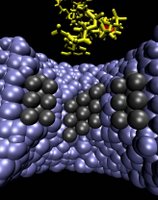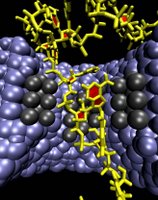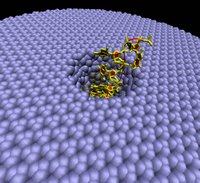Nanopore Method Could Revolutionize Genome Sequencing, By Sherry Seethaler
 |  |  |
“Current DNA sequencing methods are too slow and expensive for it to be realistic to sequence people’s genomes to tailor medical treatments for each individual,” said Massimiliano Di Ventra, an associate professor of physics at UCSD who directed the project. “The practical implementation of our approach could make the dream of personalizing medicine according to a person’s unique genetic makeup a reality.”
The physicists used mathematical calculations and computer modeling of the motions and electrical fluctuations of DNA molecules to determine how to distinguish each of the four different bases (A, G, C, T) that constitute a strand of DNA. They based their calculations on a pore about a nanometer in diameter made from silicon nitride—a material that is easy to work with and commonly used in nanostructures—surrounded by two pairs of tiny gold electrodes. The electrodes would record the electrical current perpendicular to the DNA strand as the DNA passed through the pore. Because each DNA base is structurally and chemically different, each base creates its own distinct electronic signature.
Previous attempts to sequence DNA using nanopores were not successful because the twisting and turning of the DNA strand introduced too much noise into the signal being recorded. The new idea takes advantage of the electric field that drives the current perpendicular to the DNA strand to reduce the structural fluctuations of DNA while it moves through the pore, thus minimizing the noise.
“If nature was very unkind, then the DNA would always fluctuate so much as it passes through the nanopore that measuring the current would not give us any information about what base is present at a particular location,” explained Michael Zwolak, a graduate student in physics at the California Institute of Technology who contributed to the study. “However, we have identified a particular way to operate the nanopore/electrode system that suppresses some of the fluctuations so they aren't so great as to destroy the distinguishability of the bases.”
The researchers caution that there are still hurdles to overcome because no one has yet made a nanopore with the required configuration of electrodes, but they think it is only a matter of time before someone successfully assembles the device. The nanopore and the electrodes have been made separately, and although it is technically challenging to bring them together, the field is advancing so rapidly that they think it should be possible in the near future.
In addition to the speed and low cost of the nanopore method, the researchers calculate that it will ultimately be significantly less error-prone than current methods.
“The DNA sequencing method we propose has the potential of having fewer errors than the present method, which is based on the Sanger method,” said Johan Lagerqvist, a graduate student in physics at UCSD and the lead author on the paper. “It should be possible to sequence strands of DNA that are tens of thousands of base pairs in length, possibly as long as an entire gene, in one pass through the nanopore. With the Sanger method it is necessary to chop the DNA into smaller pieces, copy the DNA and use multiple sequencing machines, which introduces additional sources of error.”
The study was funded by the National Science Foundation and by the National Human Genome Research Institute at the National Institutes of Health. The NIH funds are from a program launched in 2004 to encourage researchers to pursue a wide range of ideas to sequence a mammal-sized genome for $1,000. The researchers say that as physicists they take a unique approach to the problem.
“We don’t think of it as DNA, we view it as a bunch of atoms and electrons that behave in ways we can predict and manipulate,” said Di Ventra.
Media Contacts: Sherry Seethaler, (858) 534-4656 Comment: Massimiliano (Max) Di Ventra, (858) 822-6447
Technorati Tags: Nano or Nanotechnology and nanoparticles or Nanotech and Nanopore or nanochemistry and nanoscale or human genome and sequence DNA or medicine and physics or nanometer and nanostructures or Human Genome Research Institute
Related: Keyword Nanotech Sunday, Sunday, April 02, 2006 Quantum dot method rapidly identifies bacteria, March 26, 2006 'Custom' nanoparticles, cancer diagnosis and treatment, Sunday, March 26, 2006, Green nanochemistry, American Chemical Society symposium, Sunday, March 19, 2006 nanotechnologists demonstrate artificial muscles powered by highly energetic fuels, Sunday, Sunday, March 12, 2006 magnetic phenomenon may improve RAM memories, February 26, 2006 Nanoscience study shows that quantum dots 'talk', Sunday, February 26, 2006 Nano-bots to undertake major tasks?, Sunday, February 19, 2006 Nanotech to improve health care delivery, Sunday, February 19, 2006 nano-canary in the nanotoxicology coalmine, Sunday, December 04, 2005 Nano-cages 'fill up' with hydrogen, Sunday, November 13, 2005 Testing toxicity of nanomaterials, Sunday, October 23, 2005 single-molecule car, 'Nanocar', Sunday, August 28, 2005 Writing at the nanoscale, Thursday, May 26, 2005 discontinuous palladium, siloxane self-assembled monolayer, Sunday, May 08, 2005 Center for Nanoscale Materials, Monday, April 25, 2005 Nanomagnets, Nanocomposite, Monday, March 21, 2005 porphyrin tubes may lead to new nanodevices, inexpensive hydrogen fuel












No comments:
Post a Comment